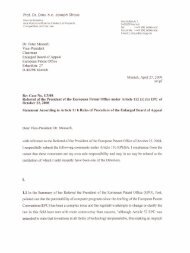Assessing the Obstacles to Industrialisation: The ... - Innovation
Assessing the Obstacles to Industrialisation: The ... - Innovation
Assessing the Obstacles to Industrialisation: The ... - Innovation
You also want an ePaper? Increase the reach of your titles
YUMPU automatically turns print PDFs into web optimized ePapers that Google loves.
z6Stephen H. Habereconomy enabled San Rafael <strong>to</strong> hold on <strong>to</strong> its control of <strong>the</strong> market over<strong>the</strong> long run. It was not until 1936 that San Rafael's monopoly wasbroken, when <strong>the</strong> Mexican government, for political reasons, decreed that<strong>the</strong> distribution of newsprint was a strategic industry that should becontrolled by <strong>the</strong> State, not by a private firm. It <strong>the</strong>refore created agovernment distribution monopoly, though San Rafael continued <strong>to</strong>control production.In short, during <strong>the</strong> 20 years between I 870 and I 910 Mexico underwenta rapid process of economic modernisation and growth. A national marketwas created by <strong>the</strong> building of a rail network, <strong>the</strong> mining sec<strong>to</strong>r wasrevitalised, a petroleum industry was created, agriculture becameincreasingly commercialised and industry moved in<strong>to</strong> a wide variety ofnew products that had never before been produced in Mexico, drivingimported goods from <strong>the</strong> market and pushing <strong>the</strong> nation's artisans <strong>to</strong> <strong>the</strong>wall. But <strong>the</strong> contradictions and obstacles inherent in <strong>the</strong> rapidindustrialisation of an economy like Mexico's prevented self-sustainingindustrialisation from taking hold. <strong>The</strong> market was still <strong>to</strong>o small <strong>to</strong>support capital goods industries (it could barely sustain consumer-goodsproducers in many lines of production), <strong>the</strong> industries that did exist wereunable <strong>to</strong> compete without extensive support and protection from <strong>the</strong>government and a group of rent-seeking financiers came <strong>to</strong> control <strong>the</strong>manufacturing sec<strong>to</strong>r.<strong>The</strong> end of <strong>the</strong> Pax Porfiriana, 1910-1930It could be argued that <strong>the</strong> process of economic growth from I 880 <strong>to</strong> 1910would have eventually overcome <strong>the</strong> obstacles which s<strong>to</strong>od in <strong>the</strong> way ofself-reinforcing industrialisation. <strong>The</strong> continued growth of <strong>the</strong> economymight have broadened and deepened <strong>the</strong> market, expanded <strong>the</strong> bankingsec<strong>to</strong>r and formed a national capital market, built an educational systemadequate <strong>to</strong> <strong>the</strong> task of developing engineering and industrial designcapabilities, and continued <strong>to</strong> break down pre-modern forms ofagricultural production. W'hile this could have happened in <strong>the</strong>ory, <strong>the</strong>reality was that <strong>the</strong> uneven process of economic growth in Mexico set offa revolution against <strong>the</strong> Diaz dicta<strong>to</strong>rship from both above and below, no<strong>to</strong>nly ending <strong>the</strong> model of growth of <strong>the</strong> Porjria<strong>to</strong>, but also producing aslowdown in industrial growth for <strong>the</strong> next 2j years.Contrary <strong>to</strong> much of <strong>the</strong> popular mythology about <strong>the</strong> effects of <strong>the</strong>hlexican Revolution (much of it motivated, as John W'omack has pointedout, more by ideological presuppositions than by an analysis of <strong>the</strong>empirical data),@ <strong>the</strong> Revolution of 1910-1 7 did not destroy hlexico's66 John Womack, '<strong>The</strong> Mexican Economy During <strong>the</strong> Revolution, 1910-1920:His<strong>to</strong>riography and ,lnalysis', ,2larxist Pt-r~pt-rttct-S,v01. I (1978), pp. 80-123.





